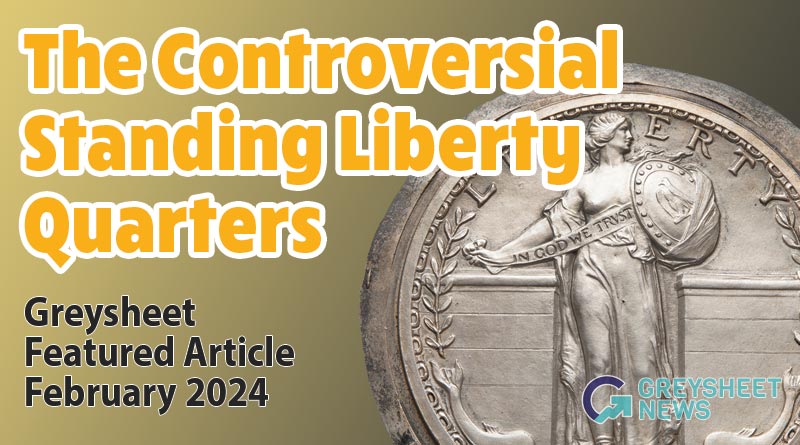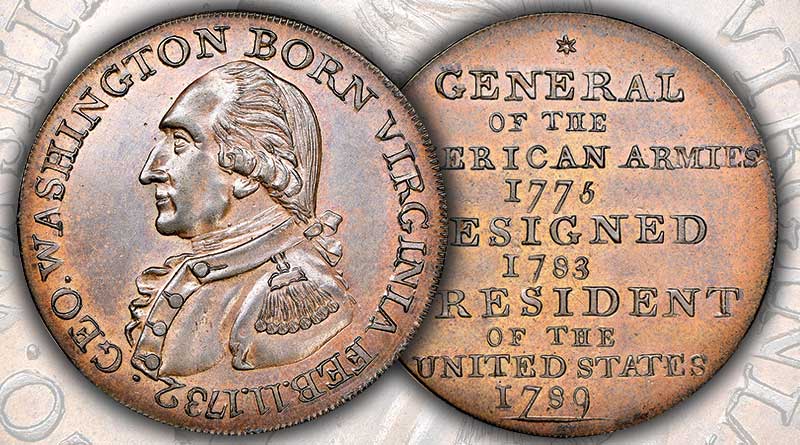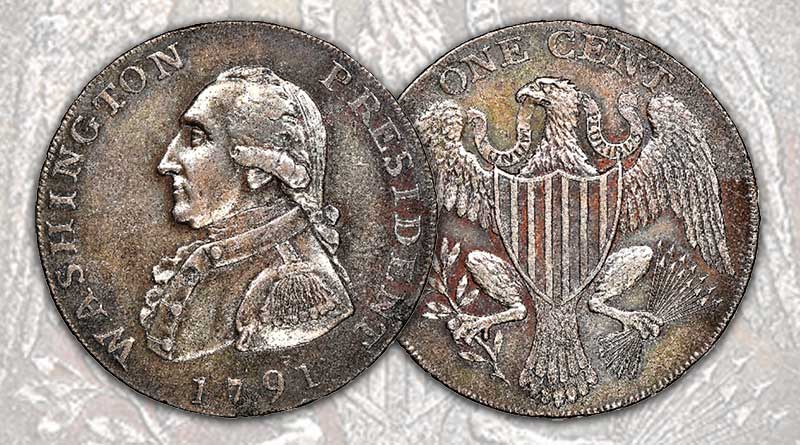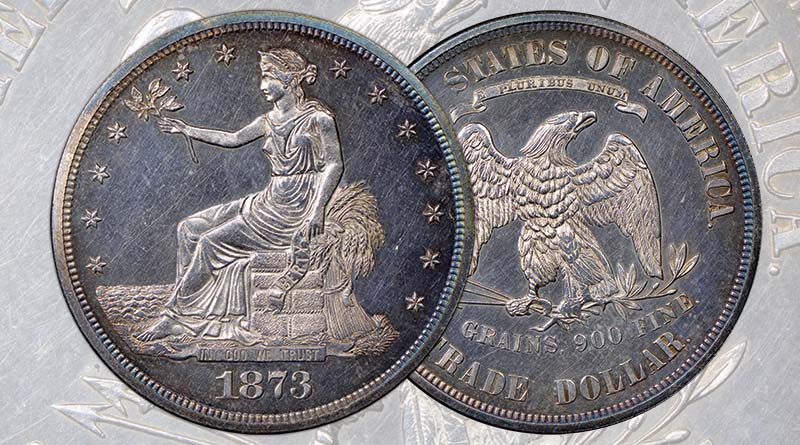The Controversial Standing Liberty Quarters
Some numismatic dealers and researchers like to infer that Standing Liberty Quarters, struck between 1916 and 1930, is shrouded in a veil of mystery or controversy. Let’s explore these so-called controversies to see if they have withstood the test of time.
Controversy #1:
Was this coin re-designed due to a misunderstanding by the Secretary of the Treasury? The U.S. Code, 31, Paragraph 5112 (d) (2) states that “the Secretary [of the Treasury] MAY change the design or die of a coin only once within 25 years of the first adoption of the design, model, hub or die for that coin.” The operative and emphasized word is MAY.
Robert W. Woolley had only served as Director of the United States Mint for less than one month, when he interpreted that U.S. Code clause that to mean that he MUST change the design of all coins that had been struck for at least 25 years. The law does not mandate change, but simply allows for change, without Congressional approval, after a run of 25 years of production.
In 1916, there were three coins—the current and circulating Dime, Quarter, and Half Dollar—that each had been struck for 25 years. The U.S. Mint’s Chief Engraver, Charles E. Barber, had designed all of them. Each of Barber’s coin denominations shared the same obverse, and the reverse of the Quarter and Half Dollar shared a common reverse. The Dime had a much simpler reverse but none of the designs were awe-inspiring, even by 19th Century standards.

The Mint Director had invited a number of accomplished artists to offer new and more artistically beautiful designs than Barber’s stodgy Miss Liberty. Of all of the designs submitted for the three coins, the works of two sculptors were selected for these three coins. Adolph A. Weinmans’ designs were chosen for the Dime (Mercury Dime) and for the Half Dollar (Walking Liberty). Hermon Atkins MacNeil’s design was selected for the Quarter. The selections were chosen by Treasury Department officials in February of 1916.
MacNeil was born in Massachusetts in 1866. Early in his artistic career he studied art in Paris and, after winning an art scholarship, he went to Rome for further study. MacNeil was primarily a sculptor and he created numerous life size sculptures of Native Americans in order to portray events in their lives.
He also created the Fountain of Liberty at the Louisiana Purchase Exhibition in 1904 and the massive sculpture of Justice, which resides atop the Supreme Court Building in Washington DC. MacNeil created a prototype of his first coin design that has survived in bronze. It looks slightly like the approved example, except that Miss Liberty was walking down steps and the columns look more like a wall. This original prototype also included two dolphins that seemingly protected the stairs down which she walked. His prototype design seemed more like a full size sculpture reduced to the size of a coin. But that was because MacNeil was much more comfortable as a sculptor than as a coin designer, as that was his art training. In fact, this was his only successful coin design.
But would his design for the new Quarter evoke Controversy #2?
Controversy #2:
MacNeil’s design was seemingly influenced by his art education in Europe but also greatly influenced by current world events and how they affected America. MacNeil depicted a heroic looking Miss Liberty standing between two large pedestal columns. As America was being pulled towards war against Germany by our friends, Great Britain and France, the design showed her with an olive branch, the eternal symbol of peace, in her right hand. But a battle shield was held in her left hand demonstrating that America was also ready for war.
The columns may have symbolically represented the two oceans—the Atlantic and the Pacific—that separated America from Europe and from Asia. The columns were adorned with 13 five-pointed stars. MacNeil’s “M” monogram is tucked next to a bottom star on one side and any mintmark would be placed next to the lowest star on the opposite column. On the column to the viewer’s left were the words “IN GOD,” while on the column to the right were “WE TRUST” with a Roman ”V” replacing the “U” in TRUST.
The reverse of the coin depicted a bald eagle in full flight with 13 five-pointed stars as well as the denomination and mottoes.
On the obverse, Miss Liberty was wearing long flowing robes a very stylistic manner, but on her right side, the robes did not cover her shoulder or her breast. After America’s long exposure to staid and conservative coinage, would the American public be offended by this portrayal of Miss Liberty, or would they barely notice the design? That depends on which numismatic author you read.
Walter Breen in his “Complete Encyclopedia of U. S. and Colonial Coins” stated that the moralists from the Society for the Suppression of Vice vehemently opposed the design. Breen believed that this organization was able to place a strong public outcry to force the Mint to reconsider the design.
But from where did that information emanate?
Roger Burdette, in his epic “Renaissance of American Coinage” asserts that Breen is incorrect and that contemporary reports do not indicate or even mention a public outcry against any elements of the design. In fact, he reminds his readers that there are and were equally as revealing or even more so in allegorical figures adorning public buildings all across the country, even in 1916.
It seems unlikely that a public outcry was the rationale for changing the design. But Treasury officials did receive complaints that, after the original mintage of 52,000 coins were in the public’s hands, merchants did not like the fact that the coins did not stack well, obviously due to the high-relief on the obverse design,
But by the time that the design changes were implemented, more than 12 million 1917 dated quarters, bearing the original design had been struck by the combined Philadelphia, Denver, and San Francisco mints.
The new designs, implemented mid-1917, lowered the obverse relief, dressed Miss Liberty’s somewhat naked upper torso, in a chain mail top, reduced the number of rivets on her shield, and raised the eagle on the reverse in order to place 3 of the 13 stars underneath the eagle. All of these changes served to make the coin more acceptable for commerce—not out of a prudish desire to make the coins less artistic.
Controversy #3:
This controversy had nothing to do with the design whatsoever. However, the coin was now well-received by the public and more than one woman claimed to be the model who posed for MacNeil as his Miss Liberty.
Dora Doscher Baum was a model and actress of the day. She publicly claimed that she was the actual model used by MacNeil to portray Miss Liberty. But Irene McDowell, also an actress and model stated that she had posed for Mac Neil. McDowell’s husband was a friend and tennis partner of MacNeil’s and for decades she let Baum take all of the public credit. However, while in her nineties, she decided to set the record straight and she claimed to be the true model.
To this day, neither woman, nor any heirs, have been able to produce a letter, note or a receipt from MacNeil for their modeling services so we may never know whether either lady, or someone else, served as MacNeil’s model.
The 1916 dated coins are extremely scarce in all grades, due to the low mintage of only 52,000. The 1917-dated coins, before the design was modified, are now referred to as Type I coins, had mintages of nearly 9 million coins from Philadelphia but less than 2 million each from Denver and San Francisco.
The remaining dates and mintmarks are all considered Type II coins. Of the remaining dates and mintmarks, there are several rare or scarce dates or variety coins. Some of them are quite valuable.
The 1918-S coin comes in two varieties—a normal date and an 18 Over 17 overdate. On most coins the overdate is easily visible with the “7” seen under the “8” and through the loops of the “8”. Although no actual mintage is known, it is a rare and popular overdate.
The 1921 coin from Philadelphia was the only coin struck bearing that date. The total mintage is only 1,916,000 making it another scarce and desirable coin. Likewise, the 1923-S coin saw the San Francisco Mint strike a mere 1,360,000 coins, making this another scarce date in all grades.
By 1925, the US Mint realized that a further modification to the design was necessary, The date was recessed as it was now one of the highest points on the coin, causing those earlier dates to wear away after a few years in circulation.
One of the last dates that is scarce due to a low mintage was the 1927-S coin, which had a tiny mintage of only 396,000 coins.
Beyond the 5 dates mentioned as scarce or rare, the remaining 33 coins are collectible in many grades even up to MS65 grade. But to understand the Standing Liberty Quarter series, one must also understand a designation that the major grading series attribute to this series. That designation is reserved for well-struck specimens. It is called “Full-Head” or abbreviated as “FH.” On a Type I coin, the Full Head designation is awarded on coins that display full detail on Miss Liberty’s hair. On Type II coins, to be awarded the Full Head designation the coins must show full details on Miss Liberty’s helmet.
The Full Head designation may dramatically affect the value of the coins as many dates, especially from the branch mints often come not very well struck.
But for all the controversies and changes made to the original design of Hermon MacNeil’s Standing Liberty Quarter, she has survived, and is as collectible and popular as she has ever been.
This design remains one of America’s most beautiful coins.

Download the Greysheet app for access to pricing, news, events and your subscriptions.
Subscribe Now.
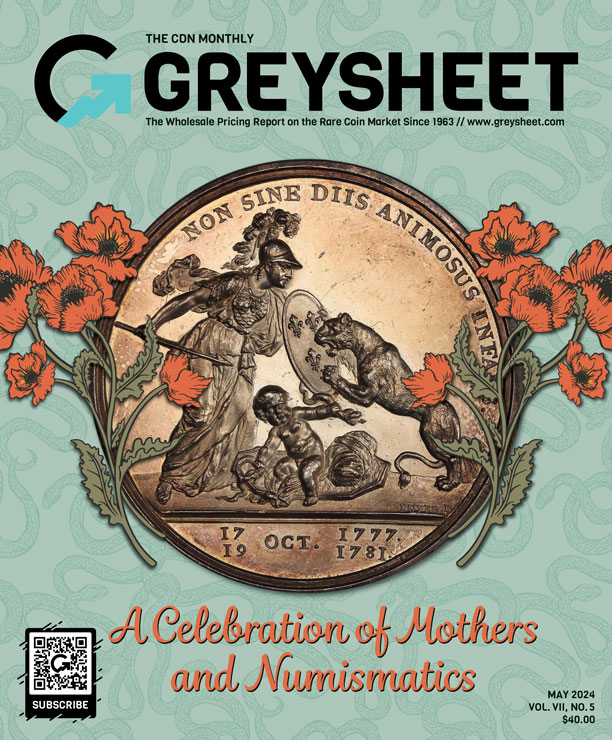
Subscribe to Monthly Greysheet for the industry's most respected pricing and to read more articles just like this.
Author: Michael Garofalo


